At the heart of this panoramic, multidimensional narrative is the compelling struggle of a young woman to lift her body and soul out of the gutter. Faber leads us back to 1870s London, where Sugar, a nineteen-year-old whore in the brothel of the terrifying Mrs. Castaway, yearns for escape to a better life. Her ascent through the strata of Victorian society offers us intimacy with a host of lovable, maddening, unforgettable characters. They begin with William Rackham, an egotistical perfume magnate whose ambition is fueled by his lust for Sugar, and whose patronage brings her into proximity to his extended family and milieu: his unhinged, childlike wife, Agnes, who manages to overcome her chronic hysteria to make her appearances during “the Season”; his mysteriously hidden-away daughter, Sophie, left to the care of minions; his pious brother, Henry, foiled in his devotional calling by a persistently less-than-chaste love for the Widow Fox, whose efforts on behalf of The Rescue Society lead Henry into ever-more disturbing confrontations with flesh; all this overseen by assorted preening socialites, drunken journalists, untrustworthy servants, vile guttersnipes, and whores of all stripes and persuasions.
Twenty years in its conception, research, and writing, The Crimson Petal and the White is teeming with life, rich in texture and incident, with characters breathtakingly real. In a class by itself, it’s a big, juicy, must-read of a novel that will delight, enthrall, provoke, and entertain young and old, male and female.
Although it’s billed as “the first great 19th-century novel of the 21st century,”
The Crimson Petal and the White is anything but Victorian. The story of a well-read London prostitute named Sugar, who spends her free hours composing a violent, pornographic screed against men, Michel Faber’s dazzling second novel dares to go where George Eliot’s
The Mill on the Floss and the works of Charles Dickens could not. We learn about the positions and orifices that Sugar and her clients favor, about her lingering skin condition, and about the suspect ingredients of her prophylactic douches. Still, Sugar believes she can make a better life for herself. When she is taken up by a wealthy man, the perfumer William Rackham, her wings are clipped, and she must balance financial security against the obvious servitude of her position. The physical risks and hardships of Sugar’s life (and the even harder “honest” life she would have led as a factory worker) contrast–yet not entirely–with the medical mistreatment of her benefactor’s wife, Agnes, and beautifully underscore Faber’s emphasis on class and sexual politics. In theme and treatment, this is a novel that Virginia Woolf might have written, had she been born 70 years later. The language, however, is Faber’s own–brisk and elastic–and, after an awkward opening, the plethora of detail he offers (costume, food, manners, cheap stage performances, the London streets) slides effortlessly into his forward-moving sentences. When Agnes goes mad, for instance, “she sings on and on, while the house is discreetly dusted all around her and, in the concealed and subterranean kitchen, a naked duck, limp and faintly steaming, spreads its pimpled legs on a draining board.” Despite its 800-plus pages,
The Crimson Petal and the White turns out to be a quick read, since it is truly impossible to put down.
–Regina Marler
- Michel Faber
- Historical fiction

![Crimson, White & Indigo: July 7 1989, JFK Stadium, Philadelphia (Live) [Explicit]](https://www.white-gifts.com/wp-content/uploads/2019/10/618urIjeheL-150x150.jpg)

![Apple Watch Series 8 [GPS 41mm] Smart Watch w/Silver Aluminum Case with White Sport Band – S/M. Fitness Tracker, Blood Oxygen & ECG Apps, Always-On Retina Display, Water Resistant](https://www.white-gifts.com/wp-content/uploads/2023/05/31sNv0RYxQL._SL500_-150x150.jpg)














